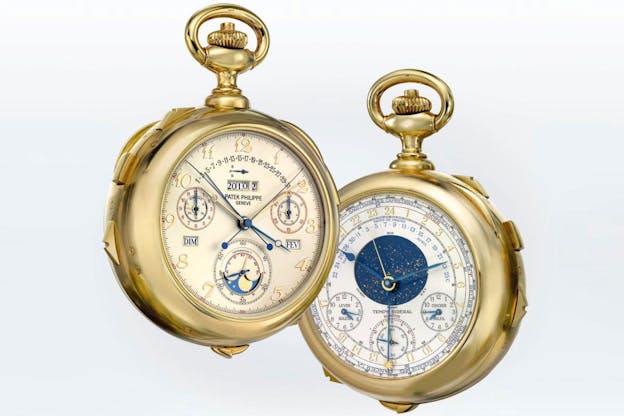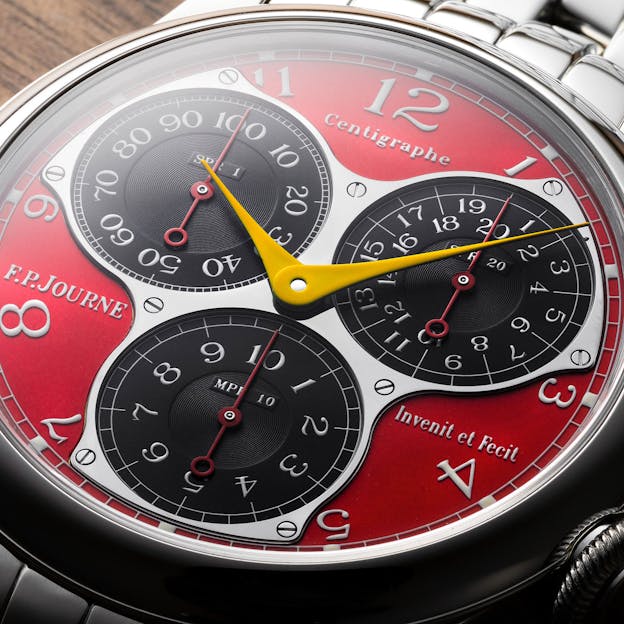Christie’s “The Art of F. P. Journe” Is A First For The Auction World
The auction is the very first thematic auction dedicated to a single independent watchmaker.
In 1989, an auction took place which redefined the auction market for watches, almost single handedly, and at virtually a single stroke. The auction was Antiquorum’s sale, “The Art of Patek Philippe,” and it brought together an astonishing assemblage of 300 watches. It was the first and also the only time that such a huge number of watches by a single manufacturer of Patek Philippe’s stature had been offered at the same time, in the same auction, and not only were the number of watches and their variety unprecedented, the auction was also undertaking with the endorsement and full cooperation of Patek Philippe itself.
One of the watch world’s best known collectors, Auro Montanari, was there.
“On April 9th 1989,” he recalled in an email, “I attended the ‘Art of Patek Phillippe’ auction in Geneva.It was the first big event in the vintage watches collecting world, the best collectors and dealers seated in the room at the Hotel des Bergues. This auction helped to establish Patek Philippe’s reputation as a luxury watch brand and durable investment, it solidified the notion that watches can be more than just ‘timepieces.’ The exceptional watch with its 33 complications, Calibre 89, created by Patek Philippe to celebrate the company’s 150th anniversary, was sold to a Japanese collector and it was, at that time, the most expensive watch in the world.”

The auction was unique in many respects but perhaps the most significant feature was not any particular watch, but rather, the overt presentation of watches by a single manufacturer, as examples of horology as an art form, with a continuity in terms of quality, internal and external style, and beauty and balance overall, which clearly distinguished Patek from its competition both historically and in the contemporary watch world.
Christie’s upcoming auction, “The Art Of F. P. Journe,” is like the Patek auction, a milestone in terms of its presentation of watches as a form of historical and contemporary art. It is also unique in that, like the Patek auction, it is a highly focused collection of major works not by a single brand, but by a single, modern, independent horological artist.
A World First In Watch Auctions
“The Art of F.P. Journe is the first live auction dedicated to a single independent watchmaker. We are extremely proud to be able to present this auction to international collectors, and to put in the limelight the genius of Francois Paul Journe,” said Christie’s head of watches in Geneva, Remi Guillemin.
Adds Pierre Halimi, F. P. Journe’s manager for the United States, “While there have been notable auctions produced by independent brands such as Royal Oak and Patek in the past, the issue lies in the misnomer of using the term ‘independents’ to refer only to small watchmakers. I use the term ‘indies’ as a shortcut, or alternatively, I use FP’s definition of distinguishing between individual watchmakers and the larger watchmaking industry. This upcoming auction is the first thematic auction for a living watchmaker and the first for an independent/indie/ watchmaker specifically.”

F. P. Journe’s watches are in general, deeply classical in design and inspiration and the lineage of design that inspires his watchmaking goes all the way back to Breguet’s innovations. Journe has also demonstrated a decades-long commitment to making watches that embrace classic proportions in terms of diameter and thickness – his watches are generally much thinner than you would expect from their complexity and with very few exceptions, resolutely round (the exceptions are generally an equally classic tonneau shape).
At the same time, they are stylistically unique – despite their roots in classicism, Journe’s watches are instantly recognizable, and moreover, his design language over the years has been one of both great imagination and inventiveness, and great consistency.
For all these reasons and more, I think it’s worth considering the term “art” as it’s applied to watches. The auction is called, “The Art Of F. P. Journe,” and not “The Watchmaking Of F. P. Journe” and it is without question true, if you ask me, that his watchmaking can be argued to rise to the level of art. The difference between art and craft is a blurry one, but generally we say that craft is the execution of a set of skills, usually learned over a long period of time, while art may require a particular set of skills but is much broader in its scope as a form of self-expression. I think that while there are certainly great watches, and a lot of them, that represent craft to some degree, it’s hard to argue that Journe’s watchmaking is anything other than a form of self-expression – and moreover, one which is made possible by a very high level of craft as well.
Watchmaking As Art
“When thinking about François-Paul Journe, a famous quote from John Ruskin comes to mind: ‘Fine art is that in which the hand, the head, and the heart of man go together,” says Remi Guillemin. “To my eyes, this quote perfectly represents F.P. Journe and is the root of his success. A unique and passionate individual, he has had the ability to significantly disrupt the world of watchmaking. The first to incorporate a remontoire d’égalité in a tourbillon wristwatch, he then went on to create the first ever wristwatch with resonance phenomenon. Focusing on his creations, without compromising, Journe has been able to share his vision of watchmaking and and imposed itself as an authority to collectors in the world of watchmaking.”

A few examples from the pieces selected serve to illustrate the point. It’s not a highly complicated watch, but lot 2013 is a rarity – one of a series of 66 watches made in collaboration with Holland & Holland, one of the best-known makers of traditional English hunting shotguns and rifles. The watch has a dial made from Damascus steel gun barrels from Holland & Holland’s museum archives. The barrels were originally made in the mid-1800s, and represent a combination of the peak of craftsmanship in both watchmaking and gunsmithing – and every watch in the auction has its own story to tell.

“The auction,” says Remi Gullemin, ” is a comprehensive representation of the evolution of F.P. Journe timepieces throughout the years. It will be a great opportunity for collectors to discover magnificent wristwatches from the beginning ot the manufacture to more recent timekeepers. The auction will feature Icons, with the example of the Tourbillon à Souscription number 2/20 (Lot 2039), which is the second timepiece ever commercialised by the watch manufacture. An interesting anecdote – the timepiece was initially sold to the same owner as the tourbillon no.1. He very kindly advanced the funds for one of his friends to possess an FP Journe timepiece.”
Another particularly interesting lot is 2032, which is one of a small series of Centigraphe Souverain watches made in platinum, with a matching platinum bracelet and Ferrari red dial. The paint for the red dials for this series were provided by Ferrari CEO Jean Todt to F. P. Journe in order to ensure that the color was the real, correct Ferrari red – only about twenty of these watches were ever made, between 2008 and 2017.

The auction itself promises to be unlike anything the watch auction world’s ever seen. Generally speaking, watch auctions are rather staid affairs but “The Art of F. P. Journe” will be presented like the major event that it is. Watchpro’s Rob Corder wrote, “The format of the auction, as Mr Guillemin suggests, will be much shorter and snappier than bloated 500 lot affairs that had people, literally, falling asleep in their seats.” The action will be live-streamed, with the auction beginning at 1PM, CEST, in Geneva.
Corder went on to say, of the 1989 Patek auction,, “The success of that auction elevated Patek Philippe to the king of auction watches it remains to this day, and the F.P. Journe sale, if successful in what is a choppy market right now, could have a similar impact on the master watchmaker’s creations, and potentially raise appreciation for other artisan independents working today.”
“The Art of F. P. Journe” may or may not set new auction records for Journe, or for watches in general. It may or may not set records for any of the individual models or limited editions represented in the auction. But records aren’t what the event really represents. Instead, I think it’s a manifestation of a transition in the world of collecting watches which is, in its own way, as much a sign of the times as “The Art of Patek Philippe” was in 1989 – a recognition that at its highest level, and practiced as a form of self-expression, watches and watchmaking can indeed rise to the level of art, and that independent watchmaking now represents, in many respects, not just the craft, but the art of watchmaking.
For more information on “The Art of F. P. Journe,” visit Christies.com. Stay tuned for updates on viewing the auction live.
For all the latest news from the world of watches, as well as the latest videos and articles from The 1916 Company, download the newest version of the The 1916 Company app for iOS and Android.

